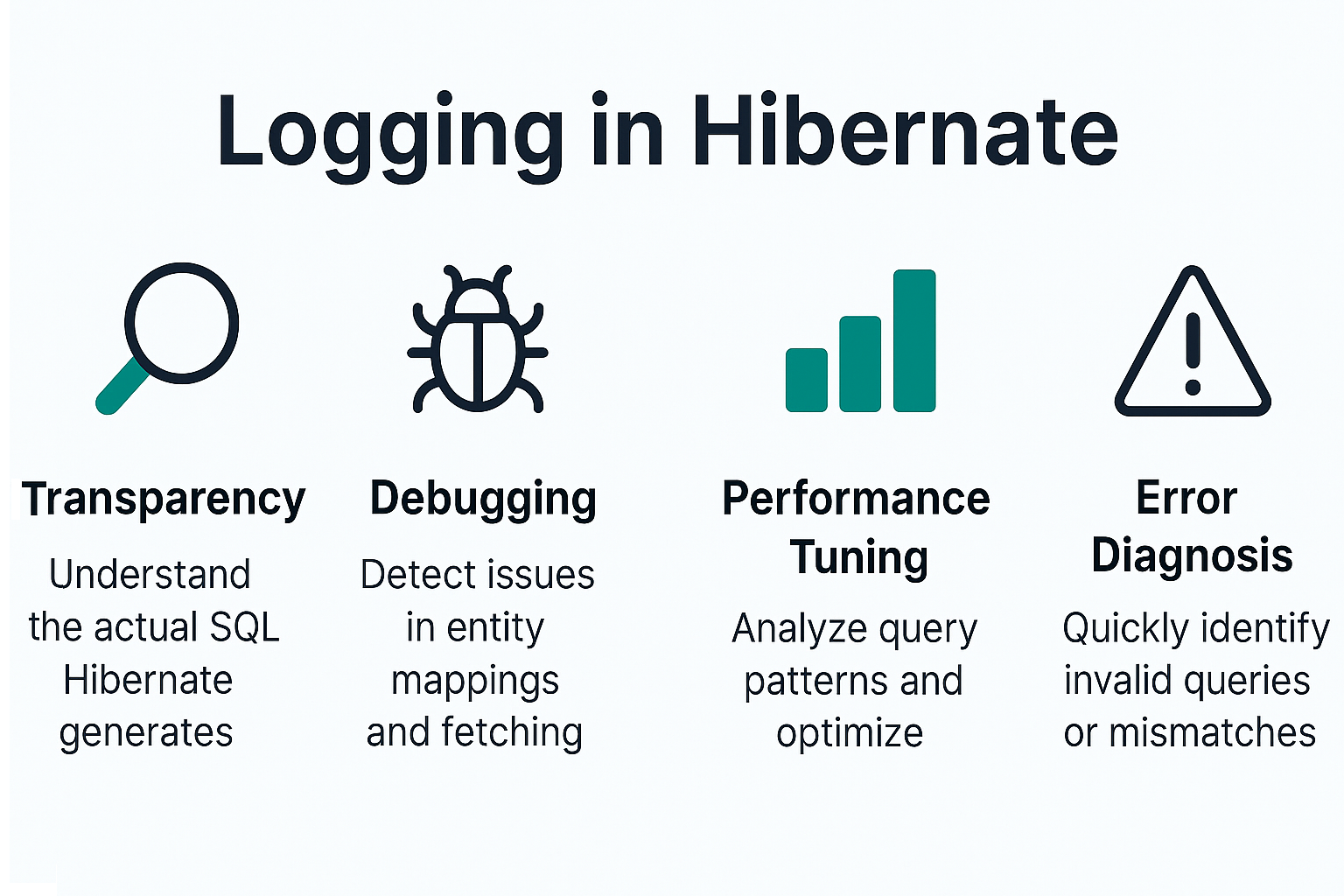In enterprise applications, debugging database interactions is critical for ensuring correctness and performance. Hibernate, being a powerful Object-Relational Mapping (ORM) tool, abstracts SQL queries but often hides the underlying operations from developers. Logging in Hibernate provides insights into generated SQL statements, execution times, parameter values, and helps diagnose issues like the N+1 select problem, improper fetch strategies, or transaction mismanagement.
This tutorial explores logging in Hibernate, focusing on SQL output, debugging techniques, configurations, and best practices for production-ready applications.
Why Logging in Hibernate Matters
- Transparency: Understand the actual SQL Hibernate generates.
- Debugging: Detect issues in entity mappings, joins, and lazy/eager fetching.
- Performance Tuning: Analyze query patterns and optimize for indexes or caching.
- Error Diagnosis: Quickly identify invalid queries or schema mismatches.
Analogy: Think of Hibernate as a chef who prepares food (SQL queries) from a recipe (your Java code). Logging lets you “peek into the kitchen” to ensure the chef is cooking exactly what you ordered.
Configuring Hibernate Logging
Using hibernate.show_sql
The simplest way to see SQL queries is by enabling the show_sql property:
hibernate.show_sql=true
hibernate.format_sql=true
hibernate.use_sql_comments=true
show_sql→ Prints SQL statements to the console.format_sql→ Beautifies SQL for readability.use_sql_comments→ Adds context in comments, useful for debugging complex queries.
Using Logging Frameworks (Recommended)
Relying on show_sql is not recommended for production. Instead, integrate Hibernate with logging frameworks like Log4j2, Logback, or SLF4J.
Example: Log4j2 Configuration
<Configuration>
<Appenders>
<Console name="Console" target="SYSTEM_OUT">
<PatternLayout pattern="%d{HH:mm:ss} %-5level %logger{36} - %msg%n"/>
</Console>
</Appenders>
<Loggers>
<Logger name="org.hibernate.SQL" level="debug" additivity="false">
<AppenderRef ref="Console"/>
</Logger>
<Logger name="org.hibernate.type.descriptor.sql.BasicBinder" level="trace" additivity="false">
<AppenderRef ref="Console"/>
</Logger>
<Root level="info">
<AppenderRef ref="Console"/>
</Root>
</Loggers>
</Configuration>
org.hibernate.SQL→ Logs executed SQL.BasicBinder→ Logs parameter bindings.
With Spring Boot
In Spring Boot, configure in application.properties:
logging.level.org.hibernate.SQL=DEBUG
logging.level.org.hibernate.type.descriptor.sql.BasicBinder=TRACE
spring.jpa.show-sql=false
Example: Logging Queries in Hibernate
Consider the following entity:
@Entity
@Table(name = "students")
public class Student {
@Id
@GeneratedValue(strategy = GenerationType.IDENTITY)
private Long id;
private String name;
private String email;
}
Insert Example
Session session = sessionFactory.openSession();
Transaction tx = session.beginTransaction();
Student s = new Student();
s.setName("John Doe");
s.setEmail("john@example.com");
session.persist(s);
tx.commit();
session.close();
Output Log (formatted):
insert into students (email, name) values (?, ?)
binding parameter [1] as [VARCHAR] - [john@example.com]
binding parameter [2] as [VARCHAR] - [John Doe]
Debugging Common Hibernate Issues with Logging
1. N+1 Select Problem
List<Student> students = session.createQuery("from Student", Student.class).list();
for (Student s : students) {
System.out.println(s.getEmail());
}
Logs may reveal N+1 SELECTs if @OneToMany relationships are lazily fetched.
Solution: Use JOIN FETCH or batch fetching.
2. Incorrect Entity Mapping
If a column is missing or misnamed, Hibernate logs will show:
Column not found: student_email
3. Transaction Failures
Without proper transaction handling, logs reveal:
Transaction not successfully started
Performance Considerations
- Avoid
show_sqlin production → Use proper log levels. - Enable SQL formatting only for debugging → Pretty-printing slows performance.
- Use parameter binding logs to detect mismatches.
- Leverage Hibernate Statistics with
hibernate.generate_statistics=true.
Best Practices for Logging in Hibernate
- Use Logback/Log4j2 with rolling policies for large logs.
- Log only in development and staging; avoid verbose logging in production.
- Prefer DEBUG and TRACE levels only when troubleshooting.
- Regularly review logs for query optimization opportunities.
📌 Hibernate Version Notes
Hibernate 5.x
- Relies on legacy
org.hibernate.SQLlogging. - Commonly used with
show_sql. - Configuration based on
hibernate.cfg.xmlor persistence.xml.
Hibernate 6.x
- Transitioned to Jakarta Persistence API (jakarta.persistence).
- Improved SQL logging support with
StatisticalLoggingSessionEventListener. - Enhanced query API for better debugging context.
Real-World Use Case: Hibernate with Spring Boot
In a Spring Boot microservice, Hibernate logging helps:
- Verify JPA repository queries.
- Tune queries with @Query annotations.
- Detect lazy initialization exceptions in REST APIs.
Analogy: Hibernate logging is like having a flight data recorder (black box) for your database interactions—helping diagnose issues after a crash.
Conclusion and Key Takeaways
- Hibernate logging reveals the hidden SQL your ORM executes.
- Use proper log levels (
DEBUG,TRACE) to capture SQL and parameter values. - Avoid relying on
show_sqlin production—use logging frameworks. - Leverage logs to debug mappings, fetching strategies, and performance issues.
FAQs
1. What’s the difference between Hibernate and JPA?
Hibernate is an implementation of JPA with additional features like caching and custom query support.
2. How does Hibernate caching improve performance?
It avoids redundant SQL calls by storing frequently accessed entities in memory.
3. What are the drawbacks of eager fetching?
It loads unnecessary data, leading to performance bottlenecks.
4. How do I solve the N+1 select problem in Hibernate?
Use JOIN FETCH, batch fetching, or second-level caching.
5. Can I use Hibernate without Spring?
Yes, Hibernate can run standalone with SessionFactory configuration.
6. What’s the best strategy for inheritance mapping?
Use JOINED for normalized schemas, SINGLE_TABLE for performance, and TABLE_PER_CLASS for flexibility.
7. How does Hibernate handle composite keys?
With @Embeddable and @EmbeddedId annotations.
8. How is Hibernate 6 different from Hibernate 5?
Hibernate 6 adopts Jakarta Persistence, improves SQL logging, and enhances query APIs.
9. Is Hibernate suitable for microservices?
Yes, but lightweight alternatives like JOOQ or Spring Data JDBC may be better for small services.
10. When should I not use Hibernate?
When raw SQL performance is critical, or schema control is more important than ORM convenience.
